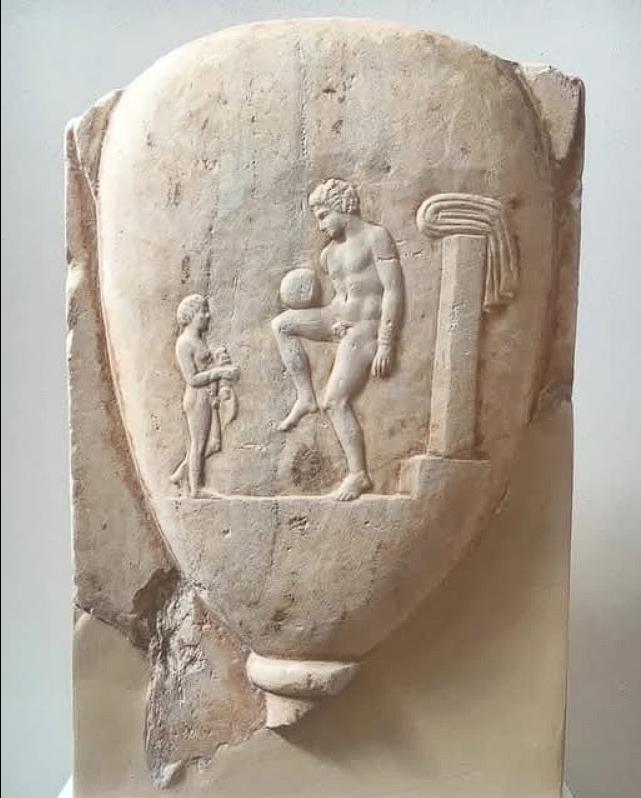“This fragment of a grave stele, hewn from the pristine white of Pentelic marble around 400–375 B.C., offers a poignant and intimate glimpse into the daily life and values of classical Greece. Discovered in Piraeus, the bustling port of Athens, this relief, now housed in the National Archaeological Museum of Athens, freezes a fleeting moment within the palaestra, the ancient gymnasium, revealing not just athletic practice but also the social dynamics and cultural ideals of the era.”
A Carved Moment in Time: The Palaestra Unveiled
- Pentelic Marble and Athenian Craftsmanship:
- Carved from the prized Pentelic marble, the same stone used for the Parthenon, this stele fragment speaks to the high level of artistic skill and the cultural importance placed on funerary monuments in ancient Athens. The choice of material itself underscores the significance of the individual being commemorated.
- The craftsmanship evident in the relief, even in its fragmented state, reveals the dedication of Athenian artisans to creating lasting tributes to the deceased, reflecting the societal values of remembrance and honor.
- The Scene in the Palaestra:
- The central focus of the relief is a nude youth engaged in ball practice within the palaestra, a common and vital part of athletic training in ancient Greece. This depiction offers a direct visual connection to the physical culture and educational practices of the time.
- The palaestra was more than just a place for physical exercise; it was a social and intellectual hub where young men honed their bodies and minds, embodying the ancient Greek ideal of a well-rounded citizen.
- Accoutrements of the Athlete:
- Behind the youth, his folded himation, a common outer garment, rests on a pillar, a simple detail that grounds the scene in everyday life. Nearby, a young servant stands attentively, holding an aryballos filled with oil and a strigil for scraping the skin after exercise.
- These accoutrements provide a tangible sense of the rituals and routines associated with athletic training in ancient Greece, highlighting the importance of hygiene and personal care in their physical culture.
Beyond the Physical: Values of Classical Greece
- The Ideal of Kalokagathia:
- The depiction of the nude youth in athletic practice embodies the ancient Greek ideal of kalokagathia—the harmonious development of both physical beauty and moral goodness. The emphasis on athletic training was not solely for physical prowess but also for cultivating discipline and character.
- This ideal permeated ancient Greek society, influencing their educational systems and their appreciation for the well-developed individual, both in body and mind.
- Social Dynamics and Hierarchy:
- The presence of the young servant highlights the social dynamics and hierarchical structures of ancient Greek society. The servant’s role in attending to the athlete underscores the division of labor and the expectations of service within their social framework.
- This detail, though seemingly minor, provides a valuable insight into the everyday realities of ancient Greek life and the social relationships that shaped their world.
- A Moment of Quiet Introspection:
- Despite the active nature of the ball practice, the relief possesses a quiet and contemplative quality. The servant’s watchful gaze and the youth’s focused concentration create a sense of stillness within the scene, suggesting a moment of personal discipline and dedication.
- This quietude invites reflection on the values of self-improvement and the dedication required to achieve physical and mental excellence, ideals highly prized in ancient Greece.
A Fragment Preserved: Echoes of a Golden Age
- Discovered in Piraeus:
- The discovery of this stele fragment in Piraeus, the bustling port of Athens, connects it to the vibrant commercial and cultural life of the ancient city. Piraeus was a hub of activity, and its cemeteries would have reflected the diverse population and their values.
- This location suggests that the individual commemorated on the stele was likely a citizen of Athens or someone closely connected to its maritime activities, further grounding the scene in the specific context of Athenian life.
- Housed in the National Archaeological Museum:
- Its current home in the National Archaeological Museum of Athens ensures the preservation and study of this important artifact. The museum serves as a repository of Greece’s rich history, allowing scholars and the public to connect with the past.
- The stele’s inclusion in the national collection underscores its significance as a primary source for understanding ancient Greek culture and society.
- A Timeless Glimpse:
- Despite being a fragment, the Piraeus stele offers a vivid and timeless glimpse into the daily life and values of the classical era. It allows us to connect with the individuals of ancient Greece on a human level, understanding their routines, aspirations, and societal structures.
- This carved moment in time transcends the millennia, offering a tangible link to the foundations of Western civilization and the enduring ideals that continue to resonate today.
Conclusion:
“This fragment of a grave stele from Piraeus, carved with exquisite detail, transports us to the heart of ancient Greece, offering a quiet yet profound glimpse into the daily life and values of the classical era. The depiction of a nude youth engaged in athletic practice, attended by his servant, encapsulates the ancient Greek ideal of physical and moral development, while the choice of Pentelic marble and the craftsmanship reflect the artistic and cultural achievements of Athens. Preserved in the National Archaeological Museum, this stele serves as a timeless echo of a golden age, reminding us of the enduring legacy of ancient Greek civilization.”

CÁC TIN KHÁC
Mary Walton: The Forgotten Inventor Who Helped Clean Up America’s Cities
Tomb of Queen Nefertari in the Valley of the Queens, Egypt
Discover the Hypostyle Hall of the Temple of Hathor at Dendera
Venus de Losange: Unveiling the Mystery of a 20,000-Year-Old Paleolithic Icon